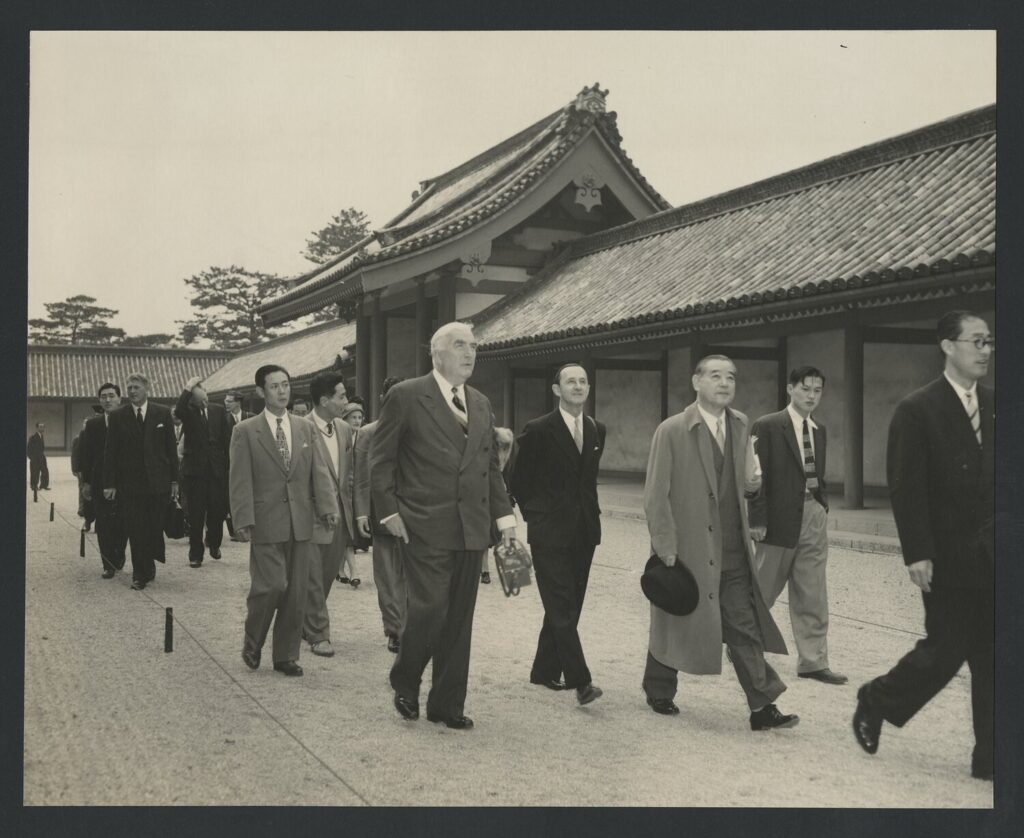On this day, 9 September 1951 (Australian time), the Menzies Government signed a peace treaty with Japan on behalf of the Australian people, bringing to a formal conclusion the conflict which had effectively ended with the Japanese surrender on 15 August 1945.
The agreement is otherwise known as the Treaty of San Francisco, the city where it was signed by 49 countries but notably not the Soviet Union and its allies. The reason for the Soviet boycott was that the treaty had been specifically designed by the United States to be ‘soft’, allowing Japan to bounce back quickly and become an important strategic ally in the Cold War. This was highly controversial within Australia, where many people were still suspicious of Japan, viewing her as a potential threat and embittered by memories of the atrocities that had been committed on Australian prisoners of war. Australia’s acquiescence to the ‘soft’ peace had arguably been bought by the ANZUS Treaty, signed just 8 days prior, but the Menzies Government still faced a difficult domestic assignment in selling this trade off to the Australian public.
A petition with 100,000 signatures protesting the ratification of the treaty was presented to Parliament in February 1952, as a deputation of union and church leaders urged that the issue be put to a referendum. They wanted the public vote because opinion polls had indicated that the majority of the population was opposed. Labor criticism was scathing, with Deputy Leader Arthur Calwell telling Parliament that ‘we certainly are not prepared to give our approval to something which we believe is a repudiation of Australian sentiment, and is not wanted by the Australian people. I am satisfied that when the history of this country covering the present period is written, the Labor party will be the only party in Australian politics that will not have to bear the obloquy and opprobrium that will most certainly attach to all those who support and endorse this unfortunate, ill-fated and indefensible document’. In this speech Calwell claimed that Japan was not just a military danger, but also that her readmittance to the realm of international diplomacy may threaten the White Australia Policy, which he vigorously supported.
Menzies on the other hand had spoken out against engendering enduring racial hatred towards Japan even during the war, insisting that ‘it will only be by a profound stirring in the hearts of men that we shall reach goodwill’. He welcomed Japan’s diplomatic re-emergence, setting up an Australian embassy in Tokyo in 1952 which would be quickly reciprocated with a Japanese presence in Canberra (Menzies had previously established Australia’s first diplomatic mission to Japan in 1940, but this had proven ill-fated and short lived). In line with domestic concerns, Menzies initially resisted Japan being added to the Colombo Plan, but by 1954 he had come to support the move and Australia personally sponsored Japan’s admission in an act of great diplomatic symbolism.
Menzies was comparatively quick to realise just how much Australian and Japanese strategic interests converged, though he was undoubtedly helped along by the private urgings of representatives of the United States Government. Both Australia and Japan were committed to containing communism, keeping the United States engaged in the Asia-Pacific region, and maintaining political stability in that region as its various independent nations emerged from the ruins of the colonial era. It was these shared interests that would ultimately underpin Menzies’s 1957 trade agreement with Japan, which would prove to be a vital economic safety net as Australia’s traditional trading partner the United Kingdom gradually withdrew into Europe.
Further Reading:
Hansard, Australian Parliamentary Debates on the Treaty of Peace (Japan) Bill 1952.
Michael Heazle, ‘The Politics Behind the Story: Sixty Years on from the 1957 Australia-Japan Commerce Agreement’, Regional Outlook Paper No. 59, 2018.
‘Treaty of Peace with Japan (with two declarations). Signed at San Francisco, on 8 September 1951’, United Nations Treaty Collection.
Sign up to our newsletter
Sign up for our monthly newsletter to hear the latest news and receive information about upcoming events.


